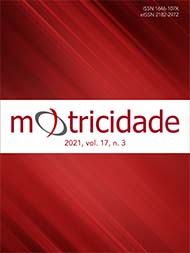Treino de força com restrição de fluxo sanguíneo em pacientes HIV positivos: um estudo de caso
DOI:
https://doi.org/10.6063/motricidade.20573Palavras-chave:
força muscular, síndrome da imunodeficiência adquirida, HIV-1, exercício, cineantropometriaResumo
Este estudo objetivou comparar respostas de neutrófilos segmentados, monócitos, linfócitos e subpopulações de linfócitos Clusters of differentitation 4 e 8 (CD4 + T e CD8 + T) ao treinamento de restrição do fluxo sanguíneo em pacientes com HIV. Participaram do estudo duas pacientes com HIV, uma paciente sedentária e outra paciente ativa fisicamente. As pacientes infetadas pelo HIV realizaram uma sessão de treinamento com restrição de fluxo sanguíneo composta por dois exercícios: supino reto e extensão do joelho. O sangue (6 ml) foi coletado para análise antes do treinamento, imediatamente após o treinamento e 30 minutos após. Ao final do treinamento com restrição de fluxo sanguíneo, foram observadas alterações percentuais no número de leucócitos em ambas as pacientes. Os monócitos mostraram respostas diferentes para as duas pacientes: uma diminuição na contagem de monócitos foi observada na paciente fisicamente ativa e um aumento na com estilo de vida sedentário. Os linfócitos apresentaram um aumento maior na fisicamente ativa do que na sendentária. Houve um aumento na proporção de linfócitos T CD4 +/CD8 + em ambas as pacientes. Concluiu-se que a restrição de fluxo sanguíneo promoveu inflamação aguda após o treinamento, demonstrada por alterações na contagem de células imunes. Essas mudanças não promoveram imunossupressão; em vez disso, foi observado um aumento na proporção de linfócitos T CD4+/CD8 +; e as infetadas pelo HIV obtiveram resultados semelhantes.
Palavras-chave: força muscular; síndrome da imunodeficiência adquirida; HIV-1; exercício; cineantropometria.
Downloads
Publicado
Edição
Secção
Licença
Os autores dos manuscritos submetidos para publicação deverão ceder, a título integral e permanente, os direitos de autor (copyright) à revista Motricidade e às Edições Sílabas Didáticas. A cedência de direitos de autor permite a publicação e divulgação do artigo em formato impresso ou eletrónico e entrará em vigor a partir da data de aceitação do manuscrito. Os autores concedem, ainda, os direitos para a revista Motricidade utilizar e explorar o respetivo artigo, nomeadamente para licenciar, ceder ou vender o seu conteúdo a bases de resumos/indexação ou outras entidades.
Nos termos da licença “Creative Commons”, os autores poderão reproduzir um número razoável de exemplares para uso pessoal ou profissional, mas sem fins comerciais. Nos termos da licença SHERPA/RoMEO, os autores poderão, ainda, disponibilizar/arquivar uma cópia digital final (versão postprint) do artigo no seu website ou no repositório científico da sua instituição.


